by Larry Williams | Feb 11, 2014

Dormant Peach Tree. Image Credit UF IFAS Environmental Horticulture Department
It is hard to believe with all of this recent cold weather, but now is the time to plant fruit trees in the Florida Panhandle. When planning what type of fruit tree to plant, correct cultivar selection should be the top priority.
The dooryard fruit producer oftentimes finds it difficult to choose the correct fruit cultivar for this area. An inappropriate choice results in disappointment when home gardeners find that they have paid for, planted and cared for fruit trees that are not adapted to the Northwest Florida climate.
Weather is probably the most important factor determining where certain fruits can and cannot be grown.
Most fruits which grow in the northern part of Florida are deciduous, which means that during the winter the trees lose their leaves and go into a period of dormancy, or rest.
During this rest period, the tree must be exposed to chilling temperatures. This exposure to the cold prepares the plant to resume active growth in spring. Temperatures below 45°F accumulated throughout winter determines the total hours of chilling. Species differ in the amount of chilling they need. This is known as a plant’s chilling requirement. Lack of enough chill hours result in sparse foliage and little to no flower production. And if there are no flowers, there will be no fruit.
North Florida receives between 400 to 650 hours below 45°F during the average winter. This provides enough chill hours for a few apple cultivars such as Anna, Ein Shemer, Dorsett Golden, TropicSweet and Shell. However, it does not provide the chill hours required for many of the more common varieties such as Red Delicious and Golden Delicious.
This same environmental factor holds true for most deciduous fruit trees. For example, some of the better known peach cultivars, such as Elberta and Bell of Georgia, perform poorly here following most winters. Both require roughly twice as many chill hours as the Panhandle receives during most winters. There are a few peach cultivars that perform OK in our area.
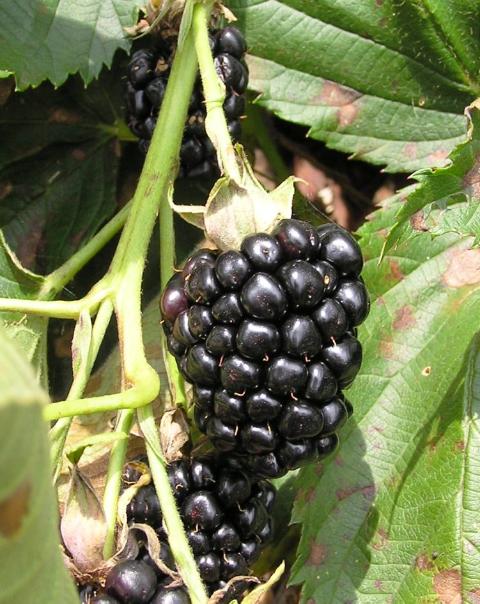
Blackberry Fruit. Photo Credit: Theresa Friday, Santa Rosa County, UF IFAS Extension
The results of selecting the wrong cultivar is only one of the disappointments experienced by those wishing to grow fruits in North Florida. Even when the correct cultivar is selected, many fruit enthusiasts (people who have dreams of homemade peach cobbler, apple pies, plum jelly, etc.) are disappointed to see insects eating their fruit, diseases causing their fruit to rot or possibly all their fruit falling to the ground before it is ready to be eaten.
In order to be successful with fruit production in North Florida, a person needs to ask a lot of questions before planting the first plant.
- Which cultivars grow well here?
- How much care is needed to grow this type of fruit?
- Do I have the time to devote to pruning, spraying, fertilizing and watering?
If you don’t know the answers to these questions, talk to a knowledgeable employee at a local, reputable nursery, consult the Dooryard Fruit Selection publication, or call your UF IFAS Extension Office before choosing to plant fruit trees this winter.
by Larry Williams | Jan 27, 2014
This week, Northwest Florida is once again receiving some bitter cold temperatures. The freezing weather two weeks ago resulted in some cold damage to some local citrus trees. Cold injured citrus trees can take a while to become evident.
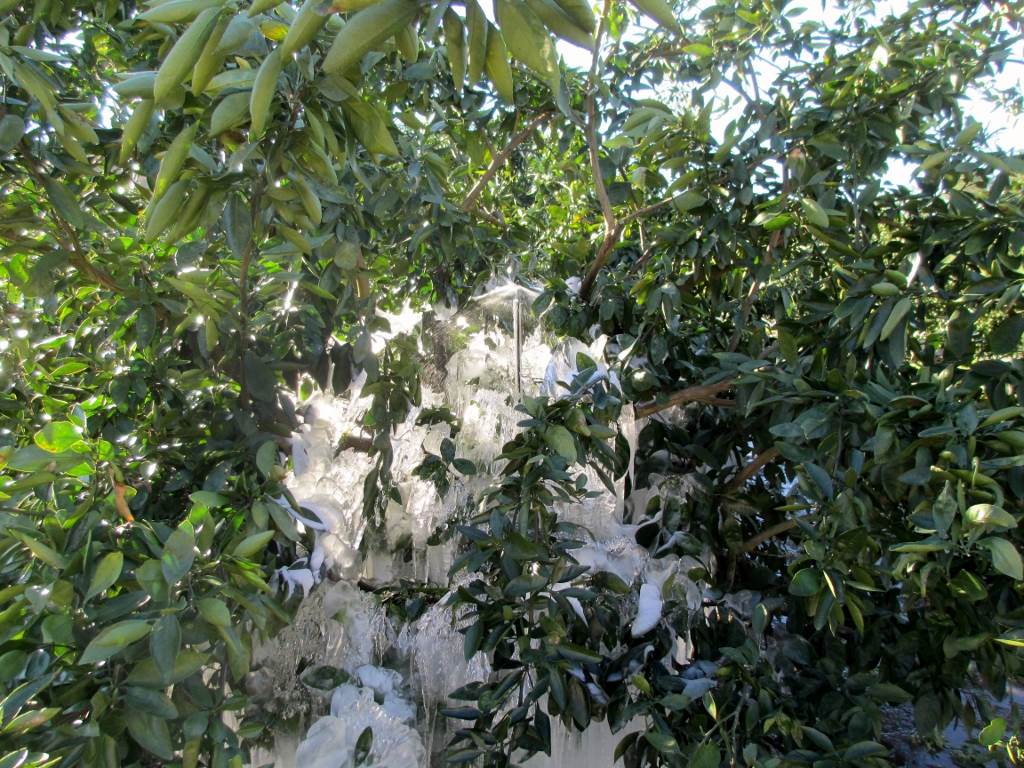
Citrus in freezing weather, under protective microsprinkler irrigation. Image Credit Doug Mayo UF IFAS
What appears to be damage will not always be permanent. Never be in a hurry to remove cold injured tissue from a citrus tree. Citrus, especially Satsuma, can be very resilient and will often re-sprout on injured tissue. Pruning before this can happen can remove fruit producing branches. Leaves on a freeze-damaged citrus tree will be hard and brittle.
If freeze damage is severe, the leaves will collapse, dry out and fall from the tree. It’s normal for leaves to take on a wilted or drooping appearance during periods of low temperatures. Don’t confuse this with freeze damage. Frozen leaves will not be wilted – they will be hard and brittle. Freeze damage can also cause the trunk and larger branches to split and the bark to become loose. Twigs and branches may continue to die for up to two years following a severe freeze.
Unless the soil becomes dry, be careful to not water cold injured citrus trees during warm periods that often follow freezes. This will delay the tree’s growth and keep the tree in a more dormant state. However, it is important to not let citrus trees go totally dry, because this will increase freeze damage. Later on, if you see that the damaged tree is putting on new growth, it’s okay to give it a little water.
It is best to not prune or fertilize citrus trees during fall and winter.Delay pruning of damaged limbs until late spring or summer because it’s difficult to determine the extent of damage until spring growth takes place. Pruning also may encourage new tender growth during the cold season.
If it appears that you’ve lost half the tree in a freeze, you’ll only need to apply about half as much fertilizer. If you have the situation where many leaves were lost but twigs and branches were not injured, you’ll need to slightly increase the amount of fertilizer. Fertilization should begin after new growth has occurred come spring. It’s a good idea to make frequent light applications rather than one heavy application.
Fertilizing your lawn during fall and winter may not only be damaging to your lawn but it can potentially cause cold injury to your citrus trees, as well. The roots on trees (including citrus) extend two to three times beyond the tree’s branches. As a result, citrus tree roots grow out into the lawn. Tree roots in the lawn are shallow. So, late applications of lawn fertilizer will impact your citrus trees as well. Your lawn and citrus needs ample time to use the fertilizer but yet still have time to go dormant before cold weather arrives.
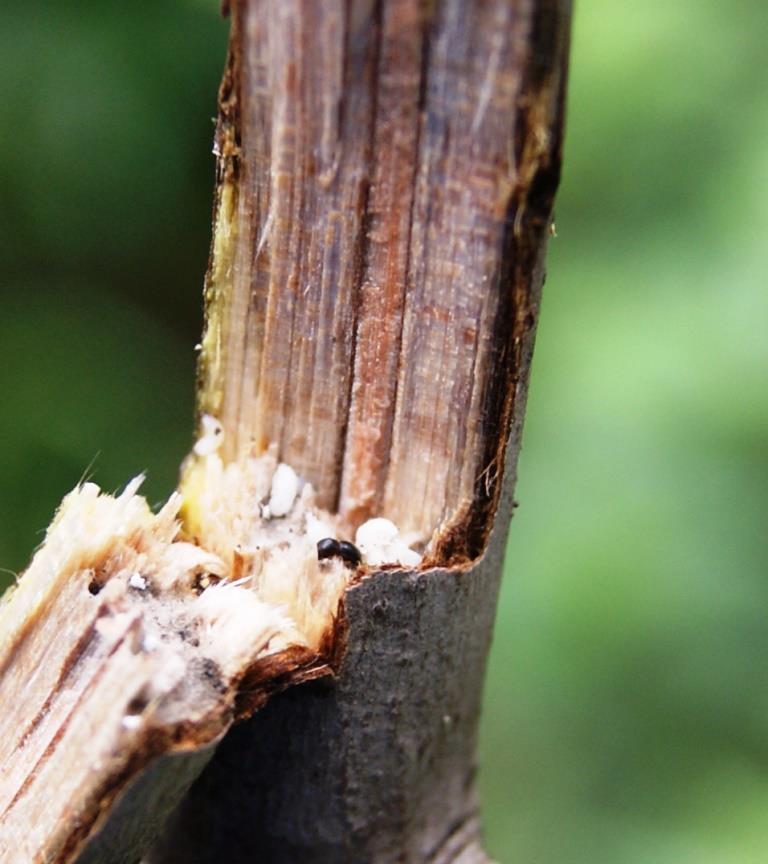
by Larry Williams | Dec 17, 2013
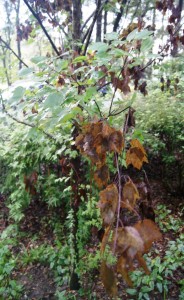
Common symptoms of the black twig borer. Image Credit Matthew Orwat UF IFAS Extension
Q. Small branches are dying in some of my trees. What’s causing this?
A. More than likely the culprit is the Black Twig Borer. This very small beetle, about 1/16 inch long, has been active this year.
Common trees attacked include cedar, golden rain tree, maple, redbud, sweetgum, loquat, dogwood, Shumard oak, Chinese elm, magnolia, Bradford pear and pecan. The beetle is not limited to these trees. And it may attack woody shrubs and grapevines.
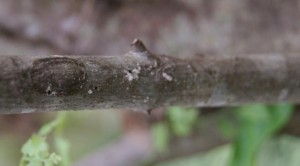
Black Twig Borer Entry Holes. Image Credit Matthew Orwat UF IFAS Extension

Black Twig Borer Entry Holes. White Frass Visible. Image Credit Matthew Orwat UF IFAS Extension
This beetle only damages branches that are approximately pencil size in diameter. These small branches die above the point of entrance with the leaves turning brown, creating a flagging effect of numerous dead branches scattered throughout the outer canopy of the tree. These dead twigs with their brown leaves are what bring attention to the infested trees.
Bending an infested twig downward will result in it snapping or breaking at the entrance/exit hole. Carefully putting the twig back together may allow you to see the hole. The hole is usually on the underside of the branch and will be very small, about the size of pencil lead in diameter. Sometimes you may see the minute, shiny black beetle and/or the white brood inside the hollowed out area of the twig at the point where it snapped.

Black Twig Borer inside the stem. Image Credit Matthew Orwat UF IFAS Extension
The black twig borer, Xylosandrus compactus, is one of the few ambrosia beetles that will attack healthy trees. However, the heavy rainfall this summer stressed many of our tree and plant species making them more susceptible to insect damage and disease.Female beetles bore into small branches or twigs of woody plants, excavate tunnels in the wood or pith and produce a brood. Damage occurs when the beetle introduces ambrosia fungi on which the larvae feed. The beetles emerge in late February, attack twigs in March and brood production begins in April. Highest population levels occur from June to September. Adults spend the winter in damaged twigs and branches. So it’s important to pickup and dispose of the small branches as they fall.
Where practical, the best control is to prune tree limbs 3-4 inches below the infested area, then remove and destroy the limbs. Proper mulching, avoiding over fertilization and irrigating during dry weather should improve tree health, allowing trees to better withstand attacks. Chemical controls are usually not practical or effective.

Entry point from a different angle. Image Credit Matthew Orwat UF IFAS Extension
Additional information on this beetle is available though the UF IFAS Extension Office, your County Forester or online at the UF IFAS Featured Creature page
by Larry Williams | Nov 18, 2013
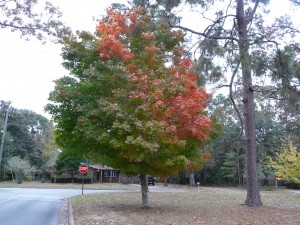
Florida maple beginning to exhibit fall color. Photo credit: Larry Williams
Although Florida is not known for the brilliant fall color enjoyed by some of our northern neighbors, we do have a number of trees that provide some fall color for our North Florida landscapes.
Our native flowering dogwood consistently provides some change in color before dropping its leaves. You can expect a red to maroon color in many of the dogwood leaves during fall.
Some of North Florida’s native maples produce good color each fall. Red maple provides brilliant red, orange and sometimes yellow leaves. The native Florida Maple, Acer saccharum var. floridum, displays a combination of bright yellow and orange color during fall. And there are many Japanese maples that provide striking fall color.
Another excellent native tree is Blackgum, Nyssa sylvatica. This tree is a little slow in its growth rate but can eventually grow to seventy-five feet in height. It deserves more use in our landscapes. It always provides a bright show of red to deep purple fall foliage.
Crape myrtle gives varying degrees of orange, red and yellow in its leaves before they fall. There are many cultivars – some that grow several feet to nearly thirty feet in height.
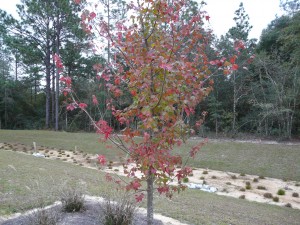
Young red maple with fall foliage. Photo credit: Larry Williams
There are a number of dependable oaks for fall color, too. Shumard, Nuttall and Turkey are a few to consider. These oaks have dark green deeply lobed leaves during summer turning vivid red to orange in fall. Turkey oak is sometimes referred to as “scrub” oak and is common on our deep sandy soils. It is short-lived as compared to most oak species, living for fifteen to thirty years before it starts to decline and die. It does not grow very large in height or trunk diameter and is not grown or sold much because it is so common in the wild. Nuttall and Shumard are becoming better available.
Sweetgum is another common native tree to considering for fall color. But some people dislike this tree because of the one to three-inch round fruit (called sweetgum balls) that it produces, which can be a nuisance as they fall on the ground around the tree. And this tree produces large surface roots that can be a problem for mowers, nearby curbs and sidewalks. But its star-shaped leaves turn bright red, purple, yellow or orange in fall.
Our native yellow poplar and hickories provide bright yellow fall foliage. And it’s difficult to find a more crisp yellow than fall ginkgo leaves.
These trees represent just a few choices for fall color. Including one or several of these trees in your landscape will allow you to enjoy the color of fall for many years right in your own backyard.
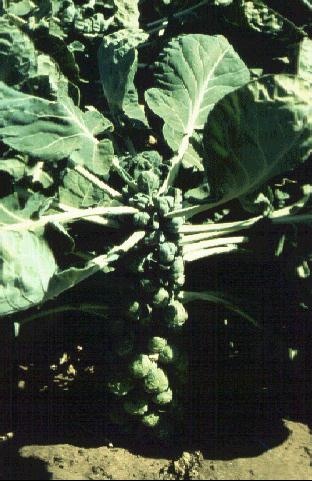
by Larry Williams | Oct 21, 2013
I tried growing Brussels sprouts for the first time a few years ago. I enjoy vegetable gardening and thought I’d try something a little different. To be honest, I wasn’t too happy with the results – nothing like starting an article on a positive note.
Actually, I don’t think I did too badly but overall I couldn’t decide if the results were worth the effort. Before I completely discourage you from trying this vegetable in your garden, I better give you some of the positives.
They are considered fairly easy to grow. They require about the same growing conditions and care as cabbage. Technically they are a type of cabbage. But instead of forming one large head, as cabbages do, they form many tiny heads along their tall stems. The round vegetable sprouts are about the size of walnuts. Each sprout resembles a miniature head of cabbage, with its layers of tightly packed leaves and central core.
Brussels sprouts are considered a cool season crop. They require cool weather for best growth. They should be grown in the winter garden in Florida. Now is a good time to plant this crop. If they are grown when temperatures are warm, the sprouts tend to be soft and open rather than solid and tightly packed.
Brussels sprouts can be started from seeds or small plants. But it may be hard to find plants for starting. Seeds can be planted directly in the garden or germinated in flats. If you start seeds in flats, plant about 25 seeds to a foot of bed and cover them with about half an inch of soil. When seedlings emerge, thin them to about an inch apart. They’re ready to plant in the garden when they’re about three or four weeks old. Plant them 30 inches apart in rows that are three feet wide.
Follow good gardening practices in watering, fertilizing and monitoring for pests.
Your sprouts are ready to harvest when they reach walnut size and feel firm. Usually, the first sprouts, near the bottom of each plant, are ready within three months. Don’t leave them on the plant too long or they’ll become yellow and tough.
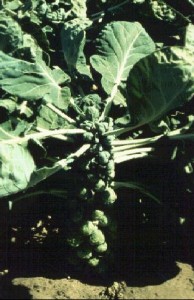
Brussels Sprout Plant
Photo Credit: UF/IFAS Extension
If you have space in your garden to devote to one crop for a minimum of three months (I left mine in the garden for five months), you might do okay with Brussels sprouts. Keep in mind they will still be producing in spring when it’s time to start planting your spring garden. The length of time it took to get a decent amount of Brussels sprouts was probably what I disliked the most about this crop.













